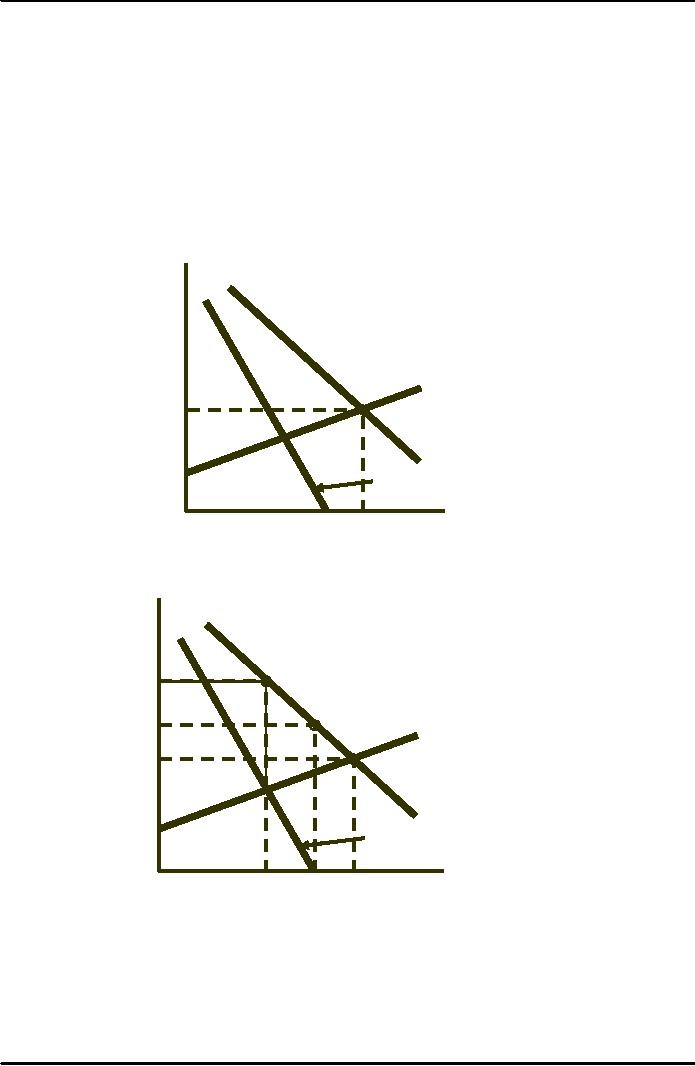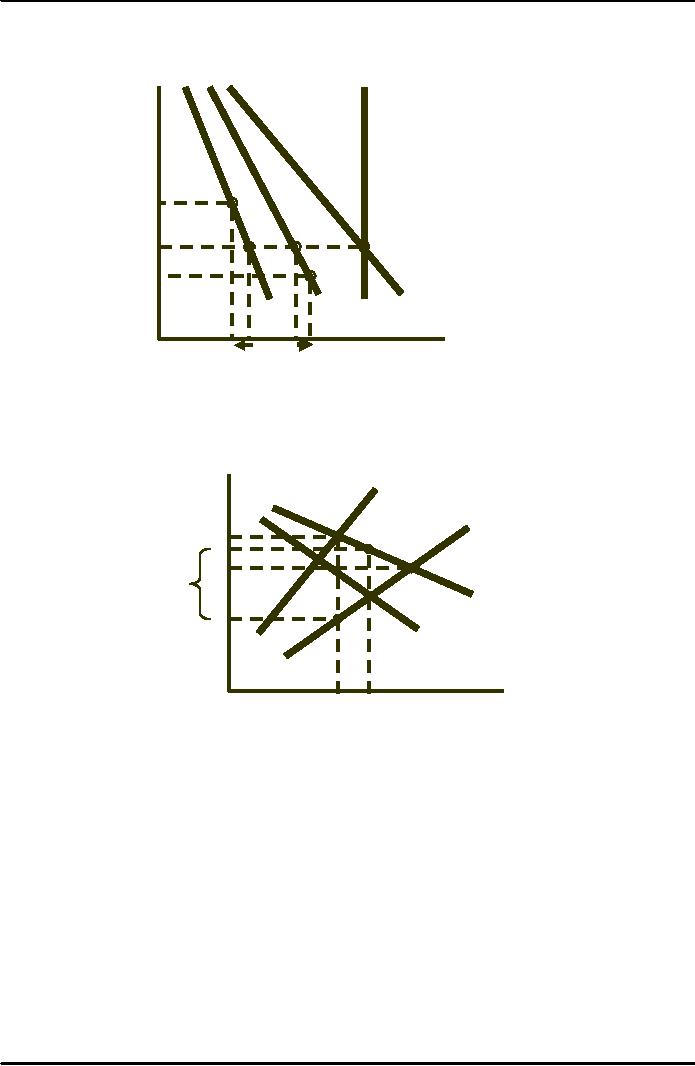 |
Factor Markets with Monopoly Power:Monopoly Power of Sellers of Labor |
| << Equilibrium in a Competitive Factor Market:Labor Market Equilibrium |

Microeconomics
ECO402
VU
Lesson
45
Factor
Markets with Monopoly
Power
Just
as buyers of inputs can have
monopsony power, sellers of
inputs can have
monopoly
power.
The
most important example of
monopoly power in factor
markets involves labor
unions.
Monopoly
Power of Sellers of
Labor
When
a labor union is a monopolist,
it
chooses
among points on the
buyer's
Wage
demand
for labor curve.
per
worker
The
seller can maximize the
number of
workers
hired, at L*,
by
agreeing that
workers
will work at wage w*.
SL
A
w*
DL
MR
L*
Number
of Workers
Monopoly
Power of Sellers of
Labor
The
quantity of labor L1 that
maximizes the rent
that
Wage
employees
earn is determined by the
intersection of
per
the
marginal revenue and supply
or labor curves;
worker
union
members receive a wage rate
of w1.
Finally,
if the union wishes to
maximize total wages
w1
paid
to workers, it should allow
L2 union
members to
be
employed at a wage rate of
w2 because
the
orginal
revenue to the union will
then be zero.
w2
SL
Economic
A
Rent
w*
DL
MR
L*
L1
L2
Number
of Workers
The
primary determinant of controlling
wage and economic rent is
controlling the supply
of
labor
A
Two-Sector Model of Labor
Employment
Union monopoly
power impacts the
nonunionized part of the
economy.
202

Microeconomics
ECO402
VU
Wage
Determination in Unionized &
Nonunionized Sectors
When
a monopolistic union
S
Wage
raises
the wage rate in
the
per
unionized
sector of the
worker
economy
from w*
to
wU,
employment
in that
sector
falls.
For
the total supply of labor
to
w
remain
unchanged, the wage
in
the
nonunionized sector
must
fall from w*
to
wNU..
w
wN
DN
D
D
Number
of Workers
ΔLMU
ΔLU
Bilateral
Monopoly
Market in which
a monopolist sells to a
monopsonist.
Wage
per
worker
ME
25
SL =
AE
20
19
wC
15
Wage
Possibilitie
DL = MRPL
10
MR
5
Number
10
20
25
40
of
Workers
Observations
Hiring without
union monopoly power
�
MRP = ME at 20 workers
and w = $10/hr
Union's
objective
�
MR
=
MC at
25 workers and w
=
$19/hr
Who
Will Win?
The
union will if its threat to
strike is credible.
The
firm will if its threat to
hire non-union workers is
credible.
If
both make credible threats
the wage will be
203
Table of Contents:
- ECONOMICS:Themes of Microeconomics, Theories and Models
- Economics: Another Perspective, Factors of Production
- REAL VERSUS NOMINAL PRICES:SUPPLY AND DEMAND, The Demand Curve
- Changes in Market Equilibrium:Market for College Education
- Elasticities of supply and demand:The Demand for Gasoline
- Consumer Behavior:Consumer Preferences, Indifference curves
- CONSUMER PREFERENCES:Budget Constraints, Consumer Choice
- Note it is repeated:Consumer Preferences, Revealed Preferences
- MARGINAL UTILITY AND CONSUMER CHOICE:COST-OF-LIVING INDEXES
- Review of Consumer Equilibrium:INDIVIDUAL DEMAND, An Inferior Good
- Income & Substitution Effects:Determining the Market Demand Curve
- The Aggregate Demand For Wheat:NETWORK EXTERNALITIES
- Describing Risk:Unequal Probability Outcomes
- PREFERENCES TOWARD RISK:Risk Premium, Indifference Curve
- PREFERENCES TOWARD RISK:Reducing Risk, The Demand for Risky Assets
- The Technology of Production:Production Function for Food
- Production with Two Variable Inputs:Returns to Scale
- Measuring Cost: Which Costs Matter?:Cost in the Short Run
- A Firm’s Short-Run Costs ($):The Effect of Effluent Fees on Firms’ Input Choices
- Cost in the Long Run:Long-Run Cost with Economies & Diseconomies of Scale
- Production with Two Outputs--Economies of Scope:Cubic Cost Function
- Perfectly Competitive Markets:Choosing Output in Short Run
- A Competitive Firm Incurring Losses:Industry Supply in Short Run
- Elasticity of Market Supply:Producer Surplus for a Market
- Elasticity of Market Supply:Long-Run Competitive Equilibrium
- Elasticity of Market Supply:The Industry’s Long-Run Supply Curve
- Elasticity of Market Supply:Welfare loss if price is held below market-clearing level
- Price Supports:Supply Restrictions, Import Quotas and Tariffs
- The Sugar Quota:The Impact of a Tax or Subsidy, Subsidy
- Perfect Competition:Total, Marginal, and Average Revenue
- Perfect Competition:Effect of Excise Tax on Monopolist
- Monopoly:Elasticity of Demand and Price Markup, Sources of Monopoly Power
- The Social Costs of Monopoly Power:Price Regulation, Monopsony
- Monopsony Power:Pricing With Market Power, Capturing Consumer Surplus
- Monopsony Power:THE ECONOMICS OF COUPONS AND REBATES
- Airline Fares:Elasticities of Demand for Air Travel, The Two-Part Tariff
- Bundling:Consumption Decisions When Products are Bundled
- Bundling:Mixed Versus Pure Bundling, Effects of Advertising
- MONOPOLISTIC COMPETITION:Monopolistic Competition in the Market for Colas and Coffee
- OLIGOPOLY:Duopoly Example, Price Competition
- Competition Versus Collusion:The Prisoners’ Dilemma, Implications of the Prisoners
- COMPETITIVE FACTOR MARKETS:Marginal Revenue Product
- Competitive Factor Markets:The Demand for Jet Fuel
- Equilibrium in a Competitive Factor Market:Labor Market Equilibrium
- Factor Markets with Monopoly Power:Monopoly Power of Sellers of Labor